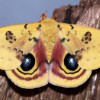 The beautiful Io moth is one of our most recognizable moths, because of its prominent hind wing eyespots. The attractive Io moth caterpillar is also well-known because of its painful sting. But like many of the other saturniid moths, is less common now in parts of its range. With the exception of Cape Cod and some of the Massachusetts islands, it is now rare in New England where it was once common, and its populations have declined in most of the Gulf States since the 1970s. This 12-page fact sheet was written by Donald W. Hall, and published by the UF Department of Entomology and Nematology, December 2014. (Photo: Donald W. Hall, UF/IFAS)
The beautiful Io moth is one of our most recognizable moths, because of its prominent hind wing eyespots. The attractive Io moth caterpillar is also well-known because of its painful sting. But like many of the other saturniid moths, is less common now in parts of its range. With the exception of Cape Cod and some of the Massachusetts islands, it is now rare in New England where it was once common, and its populations have declined in most of the Gulf States since the 1970s. This 12-page fact sheet was written by Donald W. Hall, and published by the UF Department of Entomology and Nematology, December 2014. (Photo: Donald W. Hall, UF/IFAS)
http://edis.ifas.ufl.edu/in1065
Tag: Donald W. Hall
Imperial Moth Eacles imperialis imperialis (Drury, 1773) (Insecta: Lepidoptera: Saturniidae: Ceratocampinae)
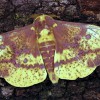 The imperial moth is one of our largest and most beautiful moths. It is also the most variable in appearance and the most widely distributed of our large eastern U.S. saturniid moths. This 9-page fact sheet was written by Donald W. Hall, and published by the UF Department of Entomology and Nematology, September 2014.
The imperial moth is one of our largest and most beautiful moths. It is also the most variable in appearance and the most widely distributed of our large eastern U.S. saturniid moths. This 9-page fact sheet was written by Donald W. Hall, and published by the UF Department of Entomology and Nematology, September 2014.
(Photo: Donald W. Hall, University of Florida) http://edis.ifas.ufl.edu/in1051
Giant Woolly Bear (larva), Giant or Great Leopard Moth (adult) Hypercompe scribonia (Stoll 1790) (Lepidoptera: Erebidae: Arctiinae)
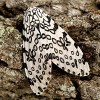 The giant leopard moth is our largest eastern tiger moth. It was formerly in the family Arctiidae, which now composes the subfamily Arctiinae in the family Erebidae. Giant leopard moths are nocturnal. Males are commonly attracted to lights at night. Sometimes dozens of males come to bright lights set out in good habitat. This 6-page fact sheet was written by Donald W. Hall, and published by the UF Department of Entomology and Nematology, August 2014.
The giant leopard moth is our largest eastern tiger moth. It was formerly in the family Arctiidae, which now composes the subfamily Arctiinae in the family Erebidae. Giant leopard moths are nocturnal. Males are commonly attracted to lights at night. Sometimes dozens of males come to bright lights set out in good habitat. This 6-page fact sheet was written by Donald W. Hall, and published by the UF Department of Entomology and Nematology, August 2014.
http://edis.ifas.ufl.edu/in1043
Puss Caterpillar (Larva), Southern Flannel Moth (Adult), Megalopyge opercularis (J. E. Smith 1797) (Insecta: Lepidoptera: Zygaenoidea: Megalopygidae) (EENY545/IN976)
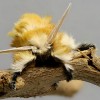 The southern flannel moth is an attractive small moth that is best-known because of its larva, the puss caterpillar, which is one of the most venomous caterpillars in the United States. This 12-page fact sheet was written by Donald W. Hall, and published by the UF Department of Entomology and Nematology, January 2013.
The southern flannel moth is an attractive small moth that is best-known because of its larva, the puss caterpillar, which is one of the most venomous caterpillars in the United States. This 12-page fact sheet was written by Donald W. Hall, and published by the UF Department of Entomology and Nematology, January 2013.
http://edis.ifas.ufl.edu/in976
Polyphemus Moth Antheraea polyphemus (Cramer) (Insecta: Lepidoptera: Saturniidae: Saturniinae) (EENY531/IN945)
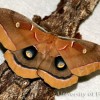 The polyphemus moth, Antheraea polyphemus (Cramer), is one of our largest and most beautiful silk moths. It is named after Polyphemus, the giant cyclops from Greek mythology who had a single large, round eye in the middle of his forehead. The name is because of the large eyespots in the middle of the moth’s hind wings. This 9-page fact sheet was written by Donald W. Hall, and published by the UF Department of Entomology and Nematology, August 2012.
The polyphemus moth, Antheraea polyphemus (Cramer), is one of our largest and most beautiful silk moths. It is named after Polyphemus, the giant cyclops from Greek mythology who had a single large, round eye in the middle of his forehead. The name is because of the large eyespots in the middle of the moth’s hind wings. This 9-page fact sheet was written by Donald W. Hall, and published by the UF Department of Entomology and Nematology, August 2012.
http://edis.ifas.ufl.edu/in945
Tawny Emperor butterfly Asterocampa clyton (Boisduval & LeConte) (Insecta: Lepidoptera: Nymphalidae: Apaturinae) (EENY528/IN933)
 The tawny emperor is a medium sized, non-descript butterfly that is common in riparian forests, but is also found in dry woods and suburbs. Larvae that develop in fall overwinter in small groups in a hibernaculum constructed by tying leaves together with silk so it stays on the tree throughout the winter. This 8-page fact sheet was written by Donald W. Hall, and published by the UF Department of Entomology and Nematology, June 2012.
The tawny emperor is a medium sized, non-descript butterfly that is common in riparian forests, but is also found in dry woods and suburbs. Larvae that develop in fall overwinter in small groups in a hibernaculum constructed by tying leaves together with silk so it stays on the tree throughout the winter. This 8-page fact sheet was written by Donald W. Hall, and published by the UF Department of Entomology and Nematology, June 2012.
http://edis.ifas.ufl.edu/in933
Eastern Black Swallowtail: Papilio polyxenes asterius (Stoll) (Insecta: Lepidoptera: Papilionidae) (EENY504/IN906)
 Although it is admired for its beauty, the eastern black swallowtail is one of the very few butterflies that may occasionally be considered a pest. Learn more in this 8-page fact sheet written by Donald Hall and published by the UF Department of Entomology and Nematology, October 2011.
Although it is admired for its beauty, the eastern black swallowtail is one of the very few butterflies that may occasionally be considered a pest. Learn more in this 8-page fact sheet written by Donald Hall and published by the UF Department of Entomology and Nematology, October 2011.
http://edis.ifas.ufl.edu/in906
Question Mark Polygonia interrogationis (Fabricius) (Insecta: Lepidoptera: Nymphalidae: Nymphalinae) (EENY506/IN908)
 This common, medium-sized butterfly of wooded areas and suburbs resembles a dead leaf when its wings are folded. Learn more in this 6-page fact sheet written by Donald Hall and published by the UF Department of Entomology and Nematology, October 2011.
This common, medium-sized butterfly of wooded areas and suburbs resembles a dead leaf when its wings are folded. Learn more in this 6-page fact sheet written by Donald Hall and published by the UF Department of Entomology and Nematology, October 2011.
http://edis.ifas.ufl.edu/in908
EENY460/IN829 Cassius blue, tropical striped blue Leptotes cassius (Cramer) (Instecta: Lepidoptera: Lycaenidae: Polyommatinae)
EENY-460, a 5-page illustrated fact sheet by Donald W. Hall and Jerry F. Butler, is part of the Featured Creatures collection. It describes this beautiful tiny blue butterfly that is locally common throughout peninsular Florida — its distribution, description, life cycle and biology, and hosts. Includes references. Published by the UF Department of Entomology and Nematology, June 2009.
http://edis.ifas.ufl.edu/IN829
EENY451/IN821 Mourning Cloak (known in the United Kingdom as the Camberwell beauty) Nymphalis antiopa (Linnaeus) (Insecta: Lepidoptera: Nymphalidae: Nymphalinae)
EENY-451, a 4-page illustrated fact sheet by Donald W. Hall and Jerry F. Butler, is part of the Featured Creatures collection. It describes this large, distinctive, and widely distributed butterfly — its distribution, description, life cycle and biology, hosts, and economic importance. Includes references. Published by the UF Department of Entomology and Nematology, June 2009.
http://edis.ifas.ufl.edu/IN821
EENY452/IN819 American snout, Libytheana carinenta (Cramer) (Insecta: Lepidoptera: Nymphalidae: Libytheinae)
EENY-452, a 4-page illustrated fact sheet by Donald W. Hall and Jerry F. Butler, is part of the Featured Creatures collection. It describes this small, dull colored butterfly with an elongated snout — its distribution, description, life cycle and biology, and hosts. Includes references. Published by the UF Department of Entomology and Nematology, June 2009.
http://edis.ifas.ufl.edu/IN819
EENY455/IN817 Eastern comma, hop merchant, comma angelwing, Polygonia comma (Harris) (Insecta: Lepidoptera: Nymphalidae: Nymphalinae)
EENY455, a 4-page illustrated fact sheet by Donald W. Hall and Jerry F. Butler, is part of the Featured Creatures collection. It describes this small inconspicuouc butterfly that prefers moist woods — its distribution, description, life cycle and biology, hosts, and economic importance. Includes references. Published by the UF Department of Entomology and Nematology, June 2009.
http://edis.ifas.ufl.edu/IN817
EENY449/IN823 American lady, American painted lady, Vanessa virginiensis (Drury) (Insecta: Lepidoptera: Nymphalidae: Nymphalinae)
EENY-449, a 6-page illustrated fact sheet by Donald W. Hall, is part of the Featured Creatures collection. It describes this attractive butterfly whose larvae (caterpillars) make nests by silking together leaves on host plants – distribution, description, life cycle and biology, and hosts. Includes references. Published by the UF Department of Entomology and Nematology, June 2009.
http://edis.ifas.ufl.edu/IN823
EENY453/IN820 Hackberry emperor, Asterocampa celtis (Boisduval and Leconte) (Insecta: Lepidoptera: Nymphalidae: Apaturinae)
EENY-453, a 5-page illustrated fact sheet by Donald W. Hall and Jerry F. Butler, is part of the Featured Creatures collection. It describs this common butterfly of river bottoms, its distribution, description, life cycle and biology, hosts, and economic importance. Includes references. Published by the UF Department of Entomology and Nematology, June 2009.
http://edis.ifas.ufl.edu/IN820
EENY448/IN814 Red-spotted purple Limenitis (=Basilarchia) arthemis astyanax (Fabricius)(Insecta: Lepidoptera: Nymphalidae: Limenitidinae)
EENY-448, a 5-page illustrated fact sheet by Donald W. Hall and Jerry F. Butler, is part of the Featured Creatures collection. It describes this beautiful forest butterfly that is also commonly seen in wooded suburban areas, its distribution, description, life cycle and biology, and hosts. Includes references. Published by the UF Department of Entomology and Nematology, May 2009.
http://edis.ifas.ufl.edu/IN814
EENY446/IN810 Red admiral Vanessa atalanta rubria(Fruhstorfer) (Insecta: Lepidoptera: Nymphalidae: Nymphalinae)
EENY-446, a 4-page illustrated fact sheet by Donald W. Hall and Jerry F. Butler, is part of the Featured Creatures collection. It describes this distinctive, medium sized, brightly colored black and orange butterfly that is common throughout much of the United States — its distribution, description, life cycle and biology, and hosts. Includes references. Published by the UF Department of Entomology and Nematology, April 2009.
http://edis.ifas.ufl.edu/IN810
EENY438/IN799 Red Bay Psyllid, Trioza magnoliae (Ashmead) (Insecta: Hemiptera: Sternorrhyncha: Psyllidae)
EENY-438, a 5-page illustrated fact sheet by Donald W. Hall, is part of the Featured Creatures collection. It describes this psyllid which causes galls on the leaves of native species of Persea bay trees — its distribution, description, life cycle and biology and economic importance. Includes selected references. Published by the UF Department of Entomology and Nematology, February 2009.
http://edis.ifas.ufl.edu/IN799
EENY436/IN793 Southern Cabbageworm (larva), Checkered White (adult) Pontia (=Pieris) protodice (Biosduval and Leconte) (Insecta: Lepidoptera: Pieridae: Pierinae)
EENY-436, a 4-page illustrated fact sheet by Donald W. Hall, is part of the Featured Creatures collection. It describes this pierid butterfly that is commong throughout much of the U. S. — its distribution, description, life cycle and biology, host, and economic importance. Includes selected references. Published by the UF Department of Entomology and Nematology, February 2009.
http://edis.ifas.ufl.edu/IN793
EENY-439/IN774 Silver-Spotted Skipper; Epargyreus clarus (Cramer) (Insecta: Lepidoptera: Hesperidae: Pyrginae)
EENY-439, a 5-page illustated fact sheet by Donald W. Hall, is part of the Featured Creatures Collection of fact sheets. It describes one of the largest, most widespread and most recognizable skippers, characterized by a large white spot on the underside of each hind wing — its distribution, description, life-cycle and biology, hosts, and economic importance. Includes references. Published by the UF Department of Entomology and Nematology, July 2008.
http://edis.ifas.ufl.edu/IN774